Uranium Investing
Outlook Reports
Featured Uranium Investing Stocks
Investor Insight
GTI Energy presents an intriguing opportunity for investors seeking exposure to the uranium sector, given its focus on ISR projects in the US aligning well with macro trends in the nuclear energy industry and geopolitical shifts favouring domestic uranium production.
Overview
GTI Energy (ASX:GTR,OTCQB:GTRIF) is an Australia-based uranium exploration and development company focused on uranium projects in Wyoming, USA, that are amenable for in-situ recovery (ISR). In uranium mining, ISR is the lowest cost and least environmentally damaging form of uranium recovery, especially when alkaline leach and ion exchange processes are utilised.
The company’s flagship Lo Herma project in the Powder River Basin is a sandstone-hosted roll front uranium deposit, which contains a recently updated mineral resource of 8.57 million pounds (Mlbs) of U₃O₈ at an average grade of 630 parts per million (JORC 2012 compliant), with a substantial additional exploration target in the range of 6 to 11 Mlbs – GTI recently completed an interim Scoping Study on this project. GTI also holds projects in the Great Divide Basin (inferred resource of 1.66 Mlbs) and Green Mountain areas of Wyoming, as well as earlier-stage conventional uranium/vanadium assets in Utah. As of the latest update, GTI has delineated total combined uranium resources of 10.23 Mlbs (indicated and inferred) and combined exploration targets ranging from 12.14 to 15.21 million tonnes across its Wyoming projects.
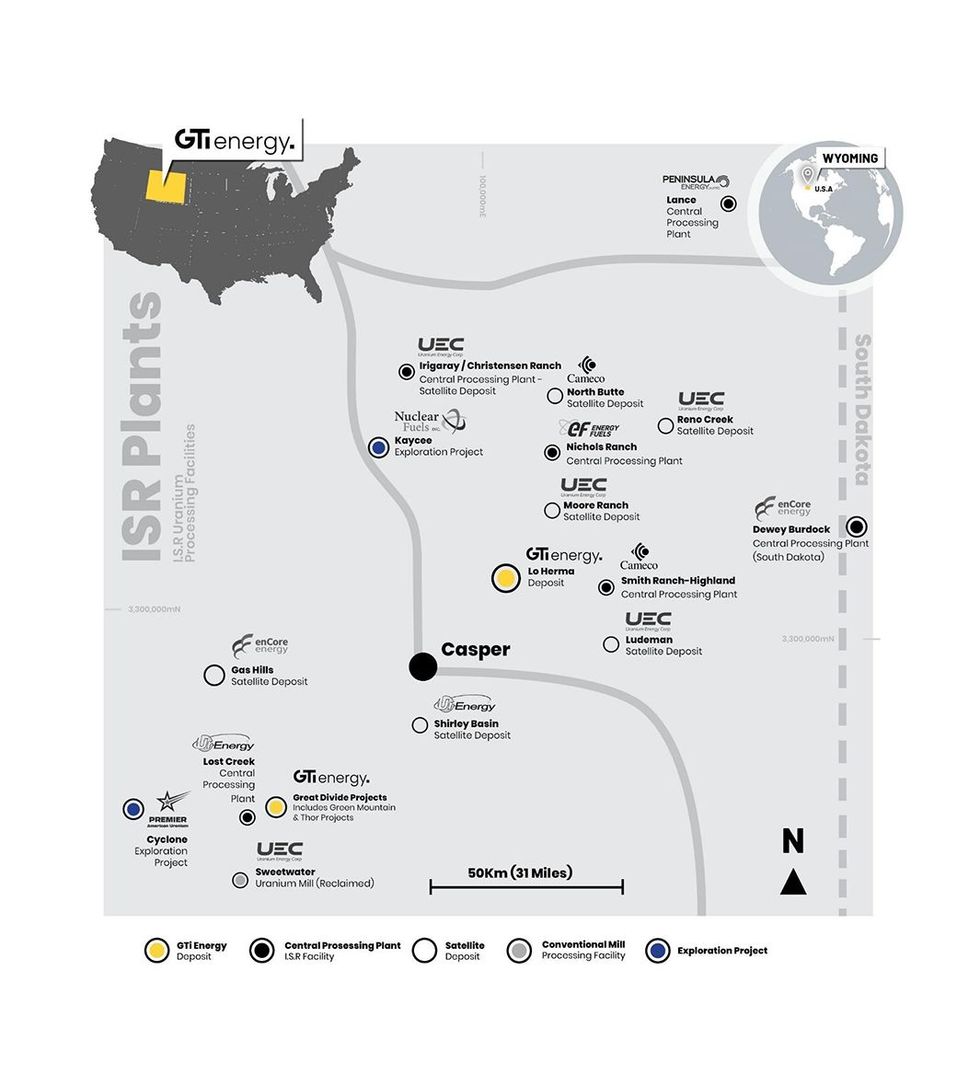
Wyoming’s ISR uranium processing assets and GTI project locations
GTI is positioning itself to take advantage of the worsening uranium supply deficit and rapidly growing demand for uranium, particularly from the United States. The US remains the world’s largest consumer of uranium but imports over 95 percent of its supply. GTI’s strategy centres on developing low-cost ISR uranium projects in Wyoming – historically one of the most productive uranium regions in the US – with established infrastructure, regulatory support, and proximity to existing ISR processing facilities.
The uranium market is experiencing a serious supply deficit and a significant resurgence in demand driven by several factors:
- Supply constraints following decades of underinvestment and an overreliance on Russian and Kazakh supply chains;
- Rapid growth in global electricity demand and recognition of nuclear energy as a clean baseload source aligned with decarbonization targets;
- Geopolitical realignment leading to a bifurcated uranium market, with the US banning imports of Russian nuclear fuel as of August 2024, intensifying the urgency for domestic supply security;
- Accelerating momentum for SMRs (Small Modular Reactors), nuclear restarts, and new gigawatt-scale builds in the US and abroad.
In the United States specifically, there is bipartisan policy support for revitalising the domestic uranium industry. Key initiatives include the formation of a strategic uranium reserve, over US$6 billion in grants for existing nuclear facilities, and tax incentives for new builds under the Inflation Reduction Act. Additionally, the US Department of Energy has called for tripling US nuclear capacity to 300 gigawatts by 2050. Demand signals are also coming from private sector growth, particularly AI-driven data centre development and long-term net-zero pledges by institutional investors and banks.
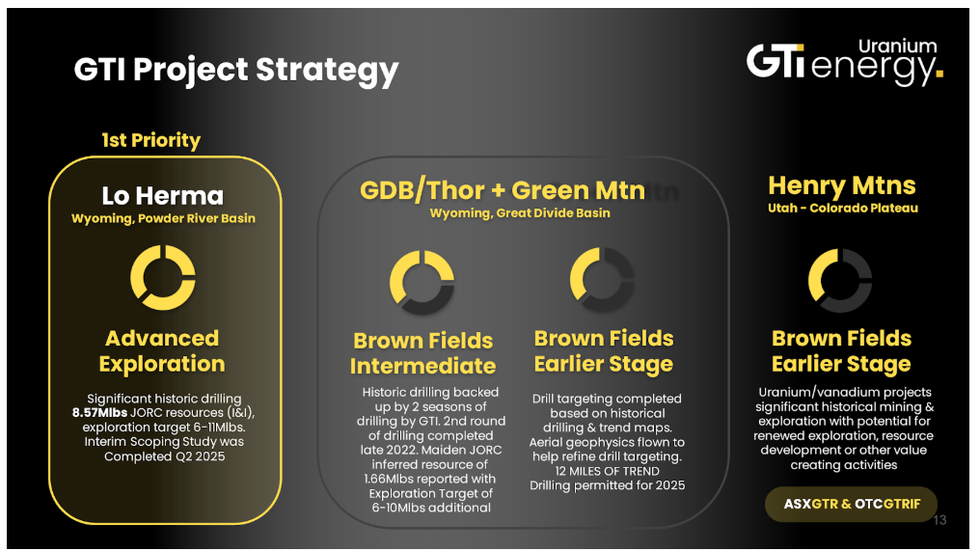
GTI Energy’s project strategy
In the longer term, GTI recognises the value potential of consolidation within the fragmented US uranium sector. The company remains open to strategic partnerships, joint ventures or merger and acquisition opportunities that could accelerate its development timeline, enhance scale, and unlock synergies. Such initiatives could ultimately strengthen GTI’s path to production and improve its overall value proposition to shareholders.
Company Highlights
- GTI Energy is focused on ISR-amenable uranium projects in Wyoming, USA.
- GTI has completed an interim Scoping Study on its flagship Lo Herma project in the Powder River Basin which contains a recently updated mineral resource of 8.57 Mlbs of U₃O₈ at average grade of 630 ppm.
- GTI also holds drill permitted projects with defined resources and exploration targets in the Great Divide Basin and Green Mountain areas in Wyoming, and uranium-vanadium assets with significant recent exploration data in Utah.
- To date, GTI has delineated total combined uranium resources of 10.23 Mlbs (indicated and inferred) and substantial combined exploration targets in the range 12 to 20 Mlbs across its Wyoming projects.
- Wyoming is a historically significant uranium producing region with existing infrastructure and a supportive regulatory environment.
- GTI is well-placed to take advantage of the worsening uranium supply deficit and rapidly growing demand for uranium, particularly from the United States, the world’s largest consumer of uranium.
Key Projects
Wyoming Uranium Projects
GTI's focus on Wyoming ISR projects positions it well to capitalize on trends in the uranium sector. ISR mining is generally faster to build, lower cost, and more environmentally friendly than conventional mining methods. Wyoming has a long history of uranium production and hosts current producers and several additional permitted processing facilities, potentially allowing for rapid development of new projects.
The Wyoming projects – comprising the Lo Herma, Great Divide Basin, and Green Mountain projects – are located in the Powder River and Great Divide Basins.
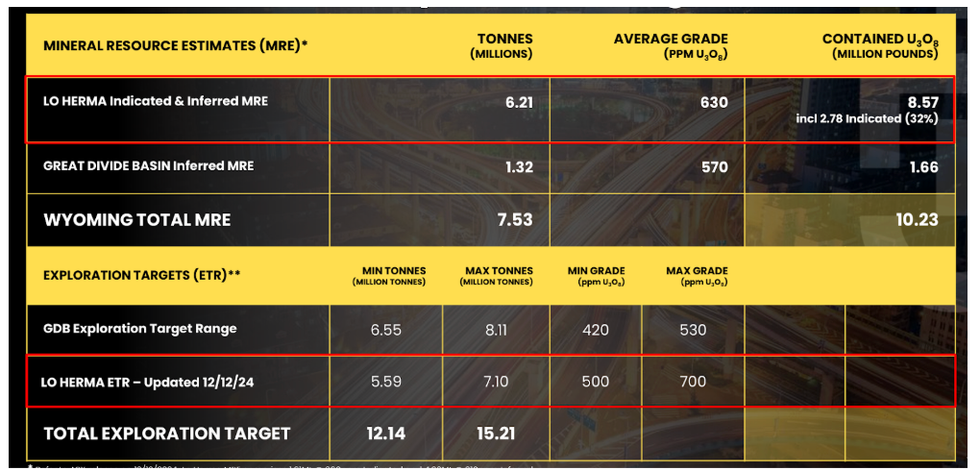
JORC Resources and Exploration Targets
Lo Herma
The company’s exploration work is currently centered on advancing its 100 percent owned flagship Lo Herma project, where drilling in 2023 and 2024 successfully verified and expanded the historical drill hole database. As of December 2024, the project hosts a JORC-compliant mineral resource estimate of 8.57 Mlbs of U₃O₈ at an average grade of 630 ppm, comprising 2.78 Mlbs indicated and 5.79 Mlbs inferred.
The Lo Herma project is located just 10 miles from Cameco's Smith Ranch-Highland facility – the largest ISR uranium plant in the United States – and is ideally situated for potential future production synergies. In addition to the current resource, the company has defined an exploration target of 6 to 11 Mlbs, with over 950 drill holes completed across the project area.
GTI completed hydrogeologic field testing and metallurgical leach studies during the March 2025 quarter. Results demonstrated that Lo Herma mineralisation is amenable to alkaline ISR recovery with uranium recoveries averaging 75 percent, consistent with other ISR operations in the district.
Following the successful completion of these studies, GTI delivered an interim scoping study in Q2 2025, managed by BRS Engineering. The study confirmed the project’s potential viability and outlined attractive baseline economics for both central processing and satellite mining development options. The company is now finalising plans for a follow-up drilling campaign in H2 2025. This next phase will include infill and step-out drilling to increase overall mineral resources and upgrade resource classification, while collecting further hydrogeological and metallurgical data.
Great Divide Basin and Green Mountain
The company continues to progress its additional Wyoming projects, including the Great Divide Basin and Green Mountain areas. Drilling is permitted for 2025, positioning GTI to unlock further value across these strategic tenements.
The Great Divide Basin project includes the Thor, Logray, Loki, Odin, Teebo and Wicket claims. It holds a JORC inferred mineral resource of 1.66 Mlbs of U₃O₈ at 570 ppm, and a defined exploration target of 6.55 to 8.11 million tonnes grading 420 to 530 ppm. The area benefits from significant historical exploration data and proximity to major uranium infrastructure, including Ur-Energy’s Lost Creek plant and Rio Tinto’s Sweetwater Mill.
GTI’s footprint in this region was expanded by acquiring the Green Mountain project, which includes 5,585 hectares of contiguous claims directly adjoining Rio Tinto’s tenements. Historical drilling and geophysical surveys confirm the presence of uranium mineralisation in sandstone-hosted roll fronts within the Battle Springs formation.
Green Mountain lies adjacent to notable regional projects including Energy Fuels’ Sheep Mountain (30 Mlbs), Ur-Energy’s Lost Soldier, and UEC’s Antelope deposits, positioning GTI near major development and production infrastructure in the basin.
Utah
Henry Mountains Uranium Project
GTI’s Henry Mountains project in Utah is a brownfields uranium-vanadium opportunity located within the prolific Colorado Plateau uranium province. Exploration has focused on a 5 km mineralised trend between the Rat Nest and Jeffrey claim groups, including the Section 36 state lease.
Uranium and vanadium mineralisation in this area is shallow – typically 20 to 30 metres deep – and has historically supported significant production. Since 1904, the district has yielded more than 92 Mlbs of U₃O₈ and 482 Mlbs of V₂O₅ from sandstone-hosted ores. The project remains a strategic asset with future development or transactional optionality as GTI advances its Wyoming portfolio.
Management Team
Bruce Lane - Executive Director
Bruce Lane has significant experience with ASX-listed and large industrial companies. Lane has held management positions in many global blue-chip companies as well as resource companies and startups in New Zealand, Europe and Australia. He holds a master’s degree from London Business School and is a graduate member of the Australian Institute of Company Directors. Lane has led a number of successful acquisitions, fund raising and exploration programs of uranium and other minerals projects during the last 20 years, most notably with ASX listed companies Atom Energy, Stonehenge Metals and Fenix Resources (FEX).
Matt Hartmann - Director
ISR uranium specialist Matt Hartmann is an executive and technical leader with more than 20 years of international experience and substantial uranium exploration and project development experience. He first entered the uranium mining space in 2005 and followed a career path that has included senior technical roles with Strathmore Minerals and Uranium Resources. He is also a former principal consultant at SRK Consulting where he provided advisory services to explorers, producers and prospective uranium investors. Hartmann’s ISR uranium experience has brought him through the entire cycle of the business, from exploration, project studies and development, to production and well field reclamation. He has provided technical and managerial expertise to a large number of uranium ISR projects across the US including, Smith Ranch – Highland ISR Uranium Mine (Cameco), Rosita ISR Uranium Central Processing Plant and Wellfield (currently held by enCore Energy), the Churchrock ISR Uranium project (currently held by Laramide Resources), and the Dewey-Burdock ISR Uranium project (currently held by enCore Energy).
Simon Williamson - Non-executive Director
Simon Williamson was general manager and director of Cameco Australia until late 2023 and has significant uranium industry experience, networks and skills from his 13 years at Cameco. During his tenure with Cameco, Williamson managed relations with key government ministers and departments and community stakeholders. He managed project approvals processes, including negotiations with State and Federal agencies and reviewing the PFS for the Yeelirrie project.
Williamson was intimately involved in obtaining environmental approval for the Kintyre and Yeelirrie uranium projects, including developing and implementing a program of environmental baseline studies, government and community consultation and negotiating land access. Prior to his appointment as general manager, he led the government and regulatory affairs, environmental and radiation safety activities of Cameco in Australia.
James (Jim) Baughman - Executive Director
James Baughman is a highly experienced Wyoming uranium geologist and corporate executive who will help guide the company’s technical and commercial activities in the US. Baughman is the former president and CEO of High Plains Uranium (sold for US$55 million in 2006 to Uranium One) and Cyclone Uranium.
Baughman has more than 30 years of experience advancing minerals projects from grassroots to advanced stage. He has held senior positions (i.e., chief geologist, chairman, president, acting CFO, COO) in private and publicly traded mining & mineral exploration companies during his 30-year career.
He is a registered member of the Society of Mining, Metallurgy, Exploration and a member of the Society of Economic Geologists with a BSc in geology (1983 University of Wyoming) and is a registered professional geologist (P. Geo State of Wyoming). Baughman is a registered member of the Society of Mining, Metallurgy, and Exploration (SME) and a qualified person (QP) on the Toronto Stock Exchange (TSX) and Australian Stock Exchange (ASX).
Petar Tomasevic - Non-executive Director
Petar Tomasevic is the managing director of Vert Capital, a financial services company specializing in mineral acquisition and asset implementation. He has worked with several ASX-listed companies in marketing and investor relations roles. Tomasevic is fluent in five languages. He is currently appointed as a French and Balkans language specialist to assist in project evaluation for ASX-listed junior explorers. Most recently, he was a director at Fenix Resources (ASX:FEX), which is now moving into the production phase. He was involved in the company’s restructuring when it was known as Emergent Resources. Tomasevic was also involved in the company’s Iron Ridge asset acquisition, the RTO financing, and the development phase of Fenix’s Iron Ridge project.
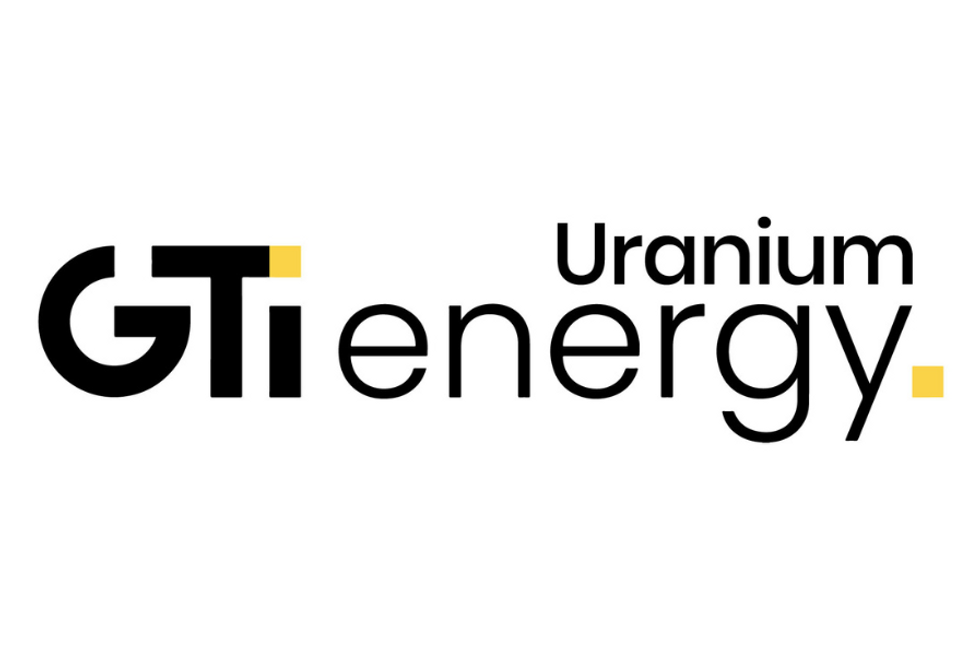
Investor Insight
Purpose-built for today’s energy transition, xU3O8 sits at the intersection of technology, finance, and nuclear energy, offering a simplified and transparent alternative to legacy uranium investments amid surging global demand. The xU3O8 token, now accessible on leading global exchanges, is a groundbreaking digital asset that provides direct, efficient exposure to the uranium market.
Overview
Uranium.io is a next-generation platform revolutionizing how investors access and trade physical uranium (U3O8). By leveraging blockchain technology, it enables individuals and institutions to directly own and trade uranium, bypassing many of the inefficiencies, opacity and high costs traditionally associated with uranium exposure. Each xU3O8 token represents real, physical uranium stored securely in a regulated depository operated by Cameco, with Archax, a UK-regulated digital asset firm, as the custodian for the physical uranium ensuring transparency and trust in asset backing.
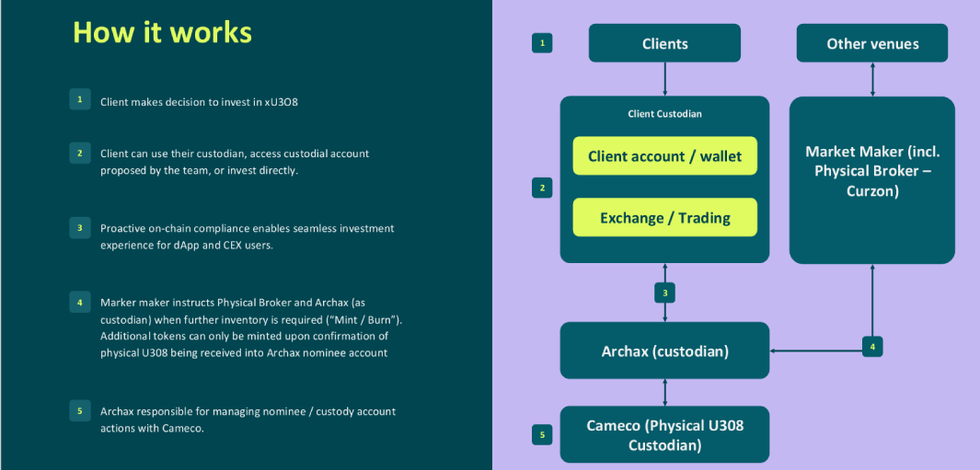
The platform is designed to meet growing investor demand for exposure to uranium, a commodity that is a critical component of the global energy transition. As countries commit to reducing carbon emissions, nuclear energy is increasingly seen as a reliable and scalable source of low-carbon electricity. Governments across North America, Europe and Asia are ramping up their nuclear energy capacities, as part of their net-zero targets. This includes restarting idled reactors, constructing new reactors, and accelerating the development of small modular reactors.
Nuclear power is also emerging as a stable and scalable option for supporting artificial intelligence (AI) data centers, which require massive amounts of electricity to operate. Industry leaders, including Microsoft, have announced nuclear energy investments, and several technology firms have secured long-term agreements for nuclear power.
Like gold and silver before it, uranium is entering a phase of financialization — with physical holding trusts, ETFs, and now platforms like uranium.io offering direct physical uranium ownership via xU3O8, making it more accessible to a wider set of investors.
As traditional financial markets converge with digital innovation, tokenized assets are becoming a preferred vehicle for commodities investing. Uranium.io’s use of the Etherlink blockchain ensures secure, real-time trading with minimal friction — a distinct advantage in an increasingly digitized investment landscape.
Development of the uranium.io platform is led by the team at London-based Trilitech, a group of entrepreneurs and technologists driving blockchain innovations.
With its emphasis on direct fractional ownership and 24/7 worldwide accessibility, xU3O8 is uniquely positioned to serve as the gateway to physical uranium exposure for a global investor base. Alignment with broader energy and digital asset trends makes it a compelling vehicle for those seeking to capitalize on uranium’s strong fundamentals and the disruptive power of decentralized finance.
In July 2025, the company launched its xU3O8 token on KuCoin, MEXC, and Gate.io — ushering in a new era of uranium investment. This simultaneous, multi-platform listing marks a major milestone in the evolution of real-world asset (RWA) tokenization, delivering institutional-grade exposure to uranium markets to a combined audience of over 115 million global traders.
By debuting across multiple top-tier platforms, xU3O8 ensures broad accessibility and liquidity for investors:
- KuCoin – With over 41 million users in 200+ countries, KuCoin offers a full suite of trading services—spot, margin, options, and futures. As a technology-first exchange focused on accessibility, KuCoin shares xU3O8’s mission to dismantle traditional investment barriers.
- MEXC – Founded in 2018, MEXC serves 36 million users globally and has seen explosive 2024 growth: 143 percent increase in spot trading and 118 percent in futures. Its intuitive platform makes crypto trading “simple, accessible, and rewarding,” mirroring xU3O8’s goal of democratizing uranium investment.
- Gate.io – Ranked among the top 3 global crypto exchanges by real trading volume, Gate.io boasts 32 million users and supports over 3,600 digital assets. With institutional-grade security and a commitment to 100 percent reserve holdings, Gate.io provides the infrastructure essential for tokenized commodity trading.
Each xU3O8 token represents fractional ownership of physical uranium ore concentrate (yellowcake) securely stored by Cameco in regulated facilities, eliminating the high barriers to entry that once restricted uranium investment to institutions and major corporations.
Company Highlights
- Uranium.io is a pioneering platform for buying and selling uranium, providing direct ownership of physical uranium via a blockchain-powered token xU3O8.
- Built on Etherlink, powered by Tezos technology, enabling transparency, low fees, energy efficiency and programmable compliance.
- FCA-regulated digital asset custodian, Archax, holds physical uranium in trust on behalf of token holders.
- Physical supply is brokered by Curzon Uranium, a trusted uranium trading and logistics partner with deep industry roots and over $1 billion in uranium trades.
- The uranium bought on the platform is physically stored at a regulated depository owned and operated by Cameco, one of the world’s leading global uranium providers/converters.
- Global 24/7 market access offering fractionalized and direct uranium exposure with real-time settlement and cross-border accessibility.
- Capitalizing on nuclear energy’s role in clean energy transition and the financialization of critical minerals.
- The company has launched the xU3O8 token across three of the world’s leading cryptocurrency exchanges: KuCoin, MEXC, and Gate.io.
Technology Platform
Uranium.io is built on a secure, decentralized technology stack that integrates blockchain infrastructure, digital asset custody, and real-world commodity supply — delivering unprecedented access and transparency to the uranium market. The platform bridges traditional commodities trading with Web3 innovation, allowing users to seamlessly acquire, hold and trade physical uranium via xU3O8 tokens.
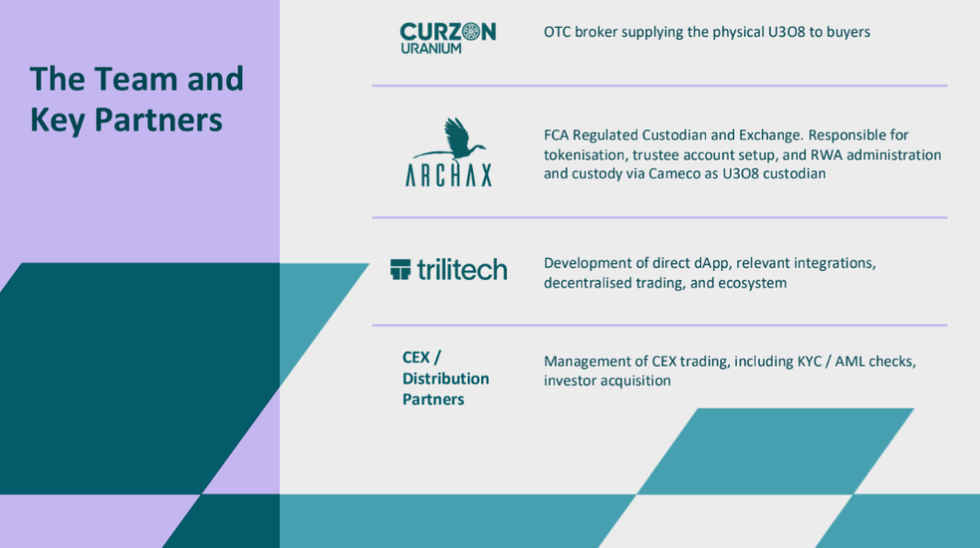
Blockchain Infrastructure: Etherlink, Powered by Tezos
At the heart of xU3O8’s digital asset engine is the Tezos blockchain, a highly secure, energy-efficient and self-amending Layer 1 protocol. Tezos is uniquely suited to power real-world asset tokenization due to its low transaction costs and energy efficiency; on-chain governance and smart contract flexibility; and enterprise-grade security and decentralization.
Tezos’ track record with real-world assets, including tokenized real estate and art, positions it as an ideal foundation for the secure, scalable digitization of uranium ownership.
Digital Custody: Archax
To ensure that each xU3O8 token is backed with physical uranium, uranium.io is supported by Archax, a London-based, digital asset custodian and exchange regulated by the Financial Conduct Authority. Archax provides regulated asset custody, KYC/AML-compliant onboarding, and real-time asset reconciliation.
Archax brings institutional-grade governance and accountability to the storage and oversight of physical uranium, ensuring that investor holdings are not just theoretical but physically secured.
Physical Supply: Curzon Uranium
Access to physical uranium is facilitated by its partnership with Curzon Uranium, a specialized uranium trading and logistics firm. Curzon acts as the platform’s uranium provider, sourcing, purchasing and delivering uranium from trusted upstream suppliers to secure storage.
Curzon’s decades of experience in uranium procurement adds physical credibility and market depth to the xU3O8 ecosystem — making the platform more than just a digital asset project, but a fully integrated uranium trading platform.
Physical uranium storage: Cameco
The physical uranium ore concentrate (U3O8) is securely stored at a regulated storage facility, operated by Cameco, one of the three globally recognized uranium conversion and storage providers. For transparency, Proof of Reserves is always available on the website and is updated with monthly statements from Cameco.
Together, Tezos, Archax and Curzon Uranium form the digital, custodial and physical backbone of the uranium.io platform. This trio of technologies and partnerships ensures a secure, compliant and efficient path for investors to gain physical uranium exposure — fractionalized, tokenized and tradable 24/7 on a global scale.
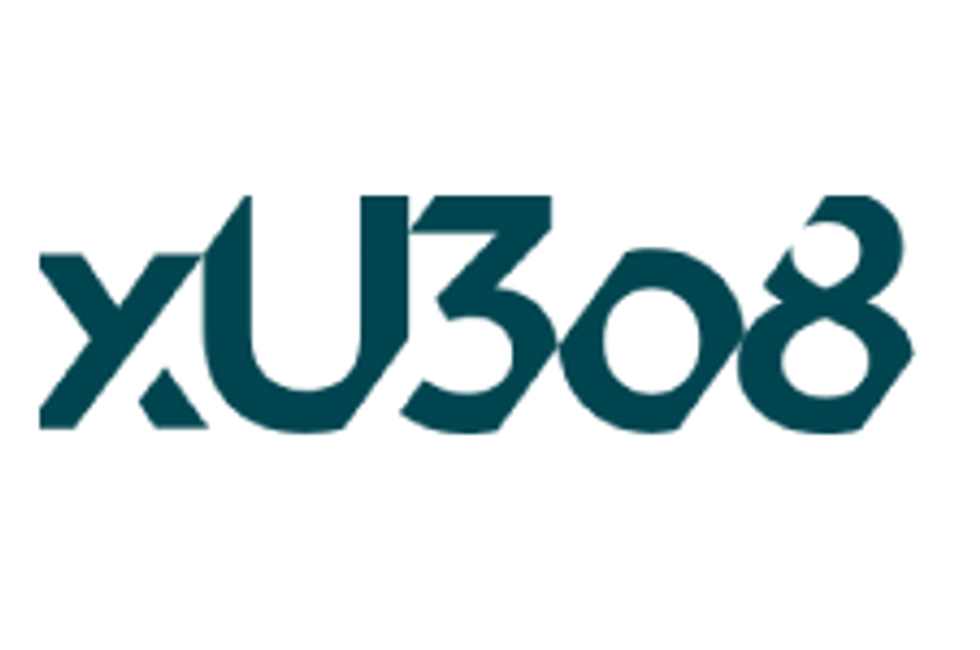
Investor Insight
With a clear, discovery-focused strategy, Terra Clean Energy is advancing one of the most unique near-surface uranium opportunities in the Athabasca Basin, targeting rapid resource growth and re-rating potential through continuous exploration, aggressive drilling, and disciplined capital deployment.
Overview
Terra Clean Energy (CSE:TCEC,OTCQB:TCEFF,FSE:C9O0) is unlocking value from its wholly owned South Falcon East project, located in the southeastern Athabasca Basin in Saskatchewan, Canada. The project uniquely positions Terra among uranium juniors due to its shallow mineralization and proximity to world-class infrastructure.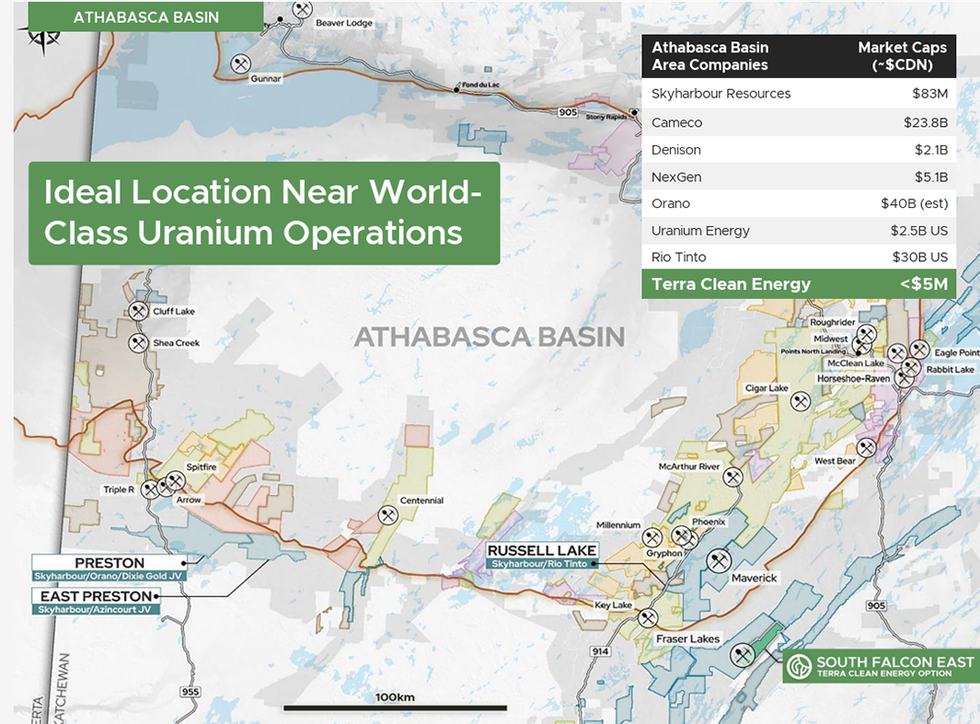
With a historical uranium resource of nearly 7 million lbs (Mlbs) U₃O₈ at Fraser Lakes Zone B, and multiple zones of confirmed mineralization and structural alteration, Terra is targeting an updated NI 43-101 resource in 2025, aiming to significantly grow its asset base. The project’s location along the Way Lake Conductor – a folded, fertile corridor – offers blue-sky potential for additional discoveries.
As global demand for uranium surges due to energy security concerns and the electrification boom (AI, EVs, nuclear baseload), Terra offers investors a rare combination of historical resource foundation, shallow mineralization, and transformational growth potential at a micro-cap valuation.
Company Highlights
- Unique, Shallow Uranium System: Only micro-cap in the Athabasca Basin advancing a near-surface uranium deposit, with significantly reduced exploration and potential development costs.
- Pounds-in-the-ground Upside: Historical resource of 6.96 Mlbs U₃O₈ and 5.34 Mlbs ThO₂, with considerable expansion potential from historical and recent drilling.
- Prime Location: Situated 55 km east of the Key Lake Mill within the prolific Athabasca Basin – home to the world’s highest-grade uranium deposits.
- Strong Technical Leadership: Led by a team with extensive uranium exploration and capital markets experience, including veterans from Skyharbour Resources and Azincourt Energy.
- Resource Update Underway: 2024–25 infill and step-out drilling will support an NI 43-101 compliant mineral resource estimate, incorporating higher-grade intercepts from Terra’s 2024 campaign.
- Re-rating Potential: Market cap under $5 million despite having a historical uranium resource, confirmed mineralized zones, and near-term catalysts.
Key Project
South Falcon East – Fraser Lakes B Deposit
Located in the southeastern margin of the Athabasca Basin, Saskatchewan, South Falcon East is Terra Clean Energy’s flagship project, covering approximately 12,234 hectares of prospective uranium ground. The property lies 55 km east of the historic Key Lake uranium mill and hosts the Fraser Lakes B deposit, which hosts an inferred historical resource of 6.96 Mlb U₃O₈ at 0.03 percent and 5.34 Mlb thorium dioxide (ThO₂) at 0.023 percent, within 10.35 Mt of material using a 0.01 percent U₃O₈ cutoff grade. While this resource is not currently classified under NI 43-101, Terra believes the data is reliable and serves as a robust foundation for continued exploration.
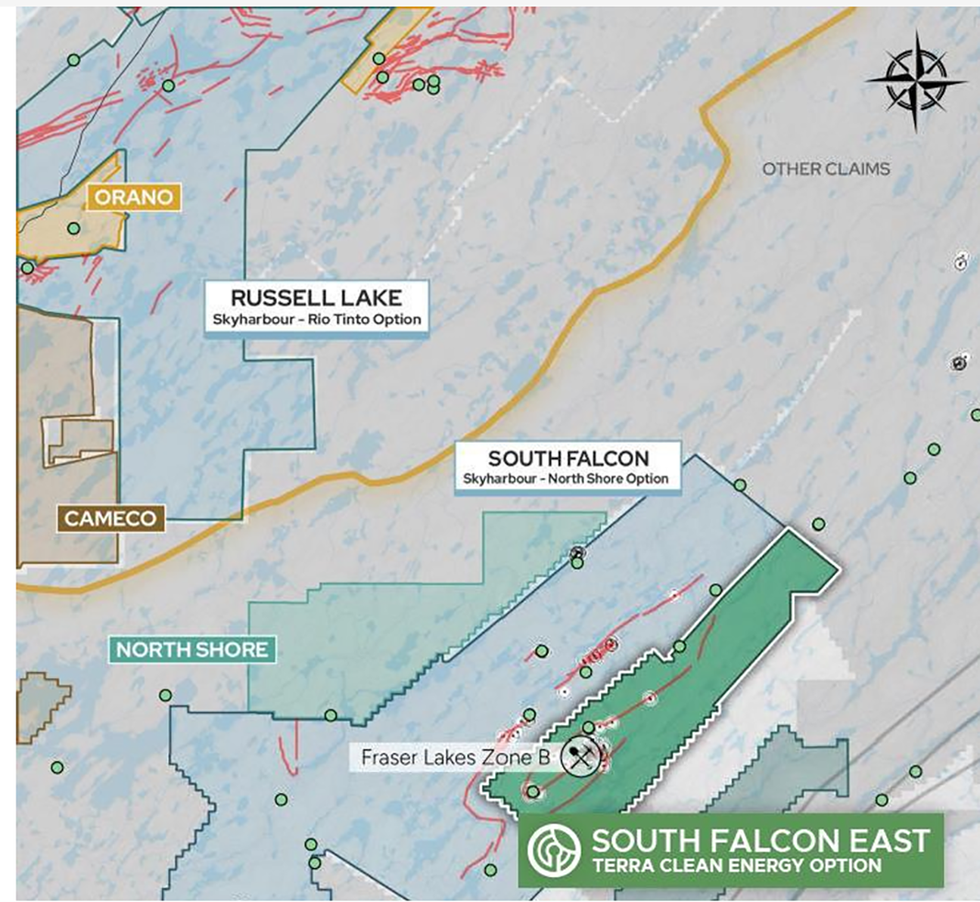
The mineralization is hosted in fractured and altered pegmatites and graphitic pelitic paragneiss, with the uranium accompanied by thorium and elevated concentrations of copper, nickel, vanadium, zinc, bismuth, molybdenum, lead and cobalt. Alteration assemblages include illite, dickite, kaolinite, chlorite, fluorite and hematite; these are classic markers of basement-hosted unconformity uranium systems. This setting, along with widespread clay alteration and structural disruption, mirrors some of the most prolific uranium systems in the basin, including Eagle Point, Millennium and Roughrider.
Fraser Lakes B sits on the central limb of the Way Lake Conductor, a folded EM corridor extending more than 25 km across the project area. This conductor hosts three major fold limbs (West, Central, and East), but only the central limb, where Fraser Lakes B is located, has been materially drilled. The deposit currently exhibits a strike length of approximately 1,400 meters, dipping northwest, and remains open in all directions. A north-northeast-trending fault, known as the T-Bone Lineament, intersects the deposit’s eastern margin, suggesting additional structural complexity and potential uranium conduits along strike.
Historic drilling from 2008 to 2015 by Skyharbour Resources and JNR Resources identified numerous mineralized intervals. Highlights include:
- 0.165 percent U₃O₈ over 2 m (within a broader 6 m grading 0.103 percent U₃O₈) in FP-15-05.
- 0.183 percent U₃O₈ over 1 m in WYL-50.
- 0.242 percent U₃O₈ over 0.5 m in WYL-61.
- 0.057 percent U₃O₈ over 5.5 m in the same hole.
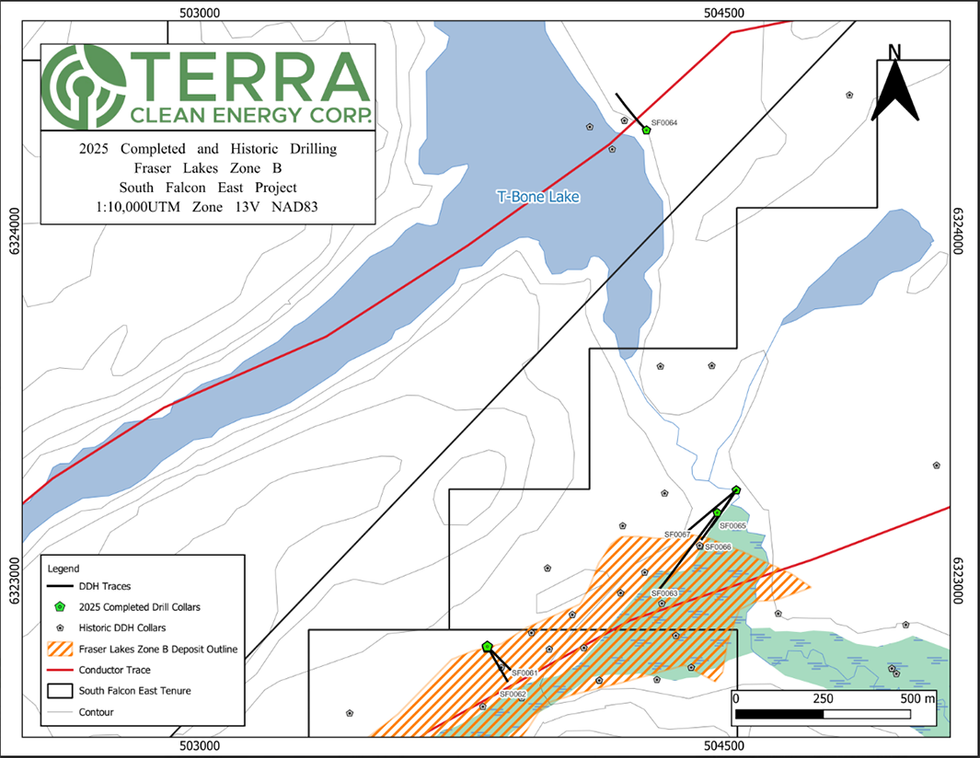
These results demonstrate multiple stacked mineralized horizons over widths up to 65 m, open to depth and laterally.
In early 2024, Terra’s Phase 1 drill program confirmed the presence of uranium-bearing pegmatites in close proximity to historical intercepts. Hole SF-0059 intersected 13.5 m of mineralization, including 0.07 percent eU₃O₈ over 1.1 m, while SF-0060 returned intervals such as 0.02 percent eU₃O₈ over 1.3 m at 142.15 m. These intercepts confirm the extension of mineralization along strike and at depth from FP-15-05 and support the hypothesis of lateral continuity and stacked mineralized bodies.
Planning for an extensive summer 2025 drill program is underway, which consists of approximately 2,500 meters. The program will test areas identified during the winter 2024 program, where it is interpreted that a north-northwest trending brittle structure, a north dipping structure with strong clay alteration, and mineralized pegmatites with hydrothermal hematite alteration hosted in graphitic pelitic gneiss all intersect.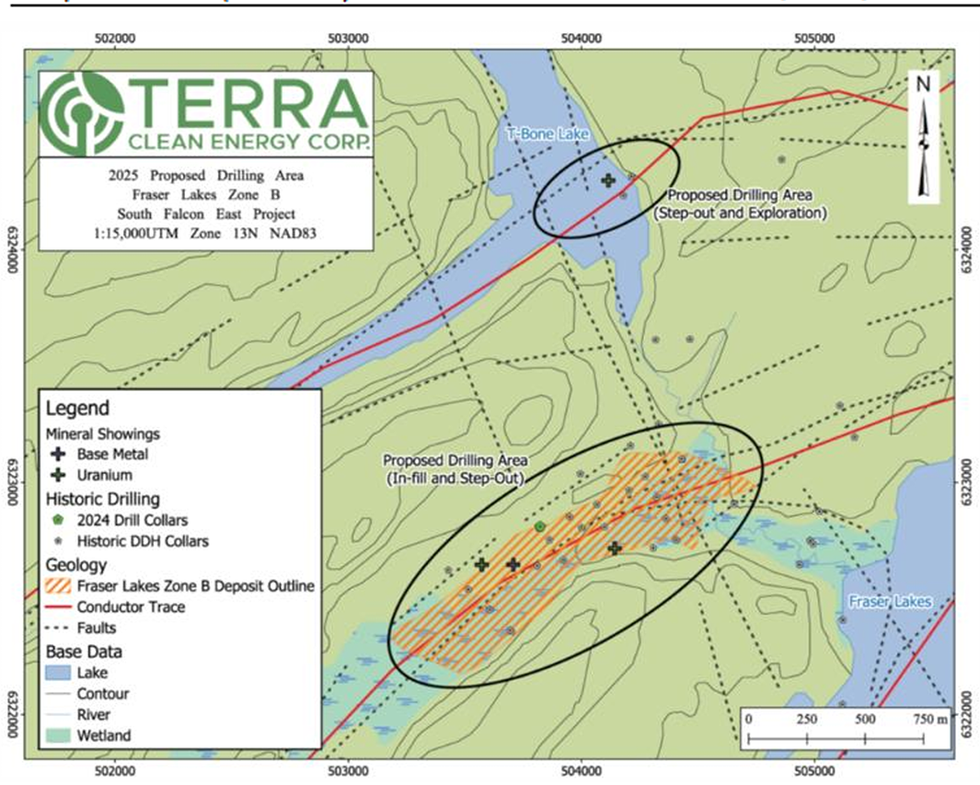
In addition to Fraser Lakes B, the company is evaluating regional targets such as T-Bone Lake, which has returned values up to 0.055 percent U₃O₈ over 0.9 m and features promising clay alteration and structural complexity similar to known high-grade deposits.
The overarching exploration thesis is that the Way Lake Conductor may host a clustered uranium system, with multiple deposits along its folded structure. Very little drilling has been conducted outside the current Fraser Lakes B footprint, giving Terra significant discovery potential across the entire 25 km strike length.
Management Team
Greg Cameron – President, CEO and Director
A seasoned capital markets professional, Greg Cameron has two decades of experience in business development, strategy and M&A. He is a former senior banker at Canaccord Genuity and Macquarie, and managing director at Colby Capital. He brings transactional and restructuring expertise critical to junior exploration growth.
C. Trevor Perkins – VP, Exploration
A professional geologist, C. Trevor Perkins has a track record in uranium exploration, including major results in the Athabasca Basin. He also serves as VP exploration for Azincourt Energy and has led exploration strategy and drill execution across multiple high-impact programs.
Alex Klenman – Director
Alex Klenman is a veteran junior mining executive with 30+ years’ experience, including uranium-specific roles. He is the CEO and director of Azincourt Energy, and has raised more than $18 million for Athabasca exploration. Klenman brings deep investor relations and financing expertise.
Tony Wonnacott – Director
Tony Wonnacott is a Toronto-based securities lawyer with more than 25 years of experience in capital markets. Instrumental in multiple successful listings and over $1 billion in financings and M&A transactions.
Brian Shin – CFO
Brian Shine is a chartered professional accountant with 15 years’ experience across roles in public companies. He specializes in reporting, risk management and corporate finance.
Jordan Trimble – Technical Advisor
Jordan Trimble is the CEO of Skyharbour Resources and a leading voice in the uranium investment community. He brings global capital markets insight and technical expertise, enhancing Terra’s industry reach and credibility.
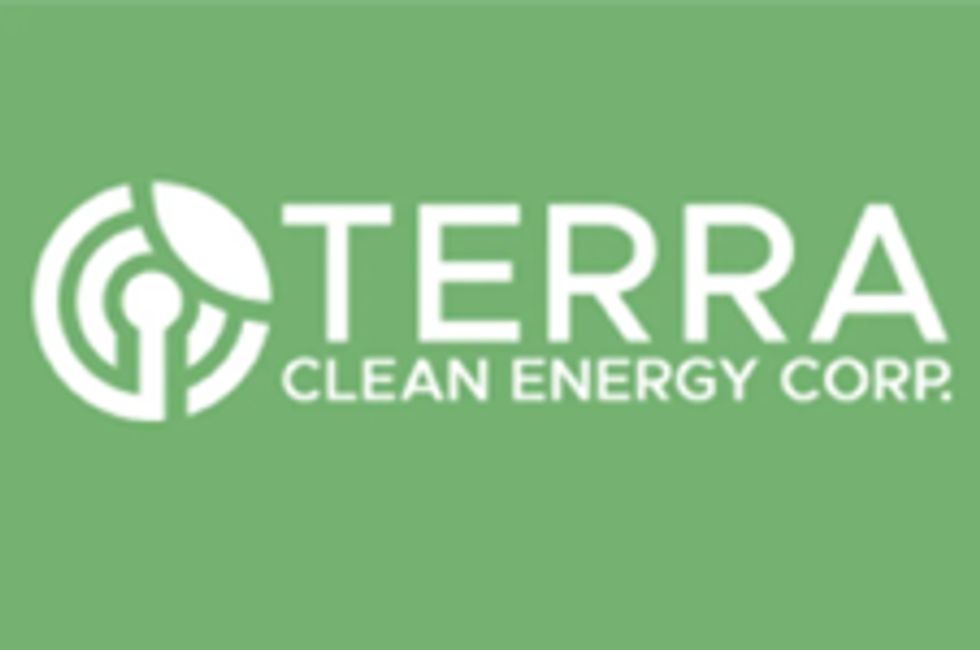
Investor Insight
Stallion Uranium offers investors a rare opportunity to gain early exposure to a company with one of the largest underexplored land packages in the world’s premier uranium district – the Athabasca Basin – guided by a discovery team with a multi-billion-dollar track record.
Overview
Stallion Uranium (TSXV:STUD,OTCQB:STLNF) is a Canadian uranium exploration company positioned for discovery in the southwestern Athabasca Basin, a frontier zone that holds tremendous untapped geological potential. With a landholding of over 709,000 acres, Stallion controls one of the largest and least explored portfolios among junior explorers in the region.
The company is leveraging a surging uranium demand, driven by more than 900 reactors across the globe currently in operation, construction or planning stages. Amid a uranium supply shortage, the Athabasca Basin, with uranium grades up to 20 times the global averages, represents the best place in the world to find the next major high-grade discovery.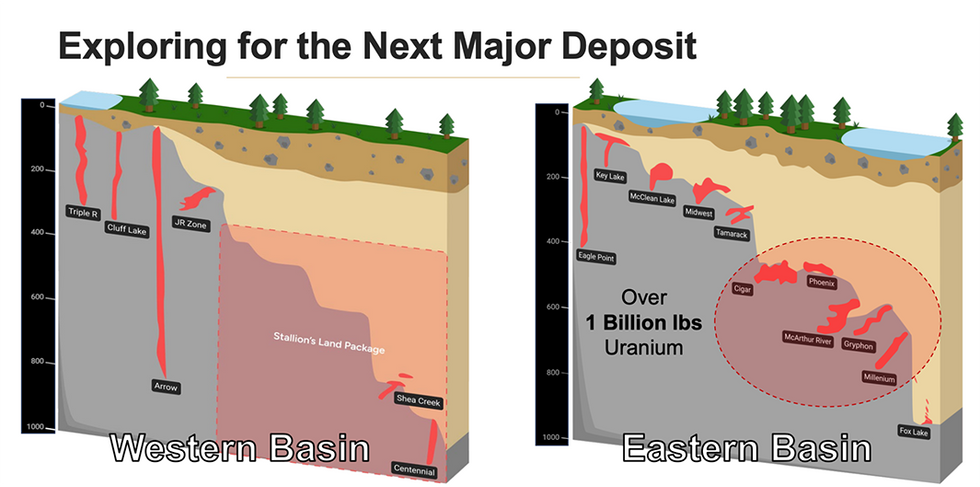
What sets Stallion apart is not just its land position, but the pedigree of its team. CEO Matthew Schwab was a key figure in the discovery of NexGen’s Arrow deposit, one of the most significant uranium finds of the past decade.
Over the past two years, Stallion has deployed airborne and ground geophysics across its land package, culminating in the identification of nine Tier-1 uranium targets. The top three – Coyote, Fishhook, and Lynx – have now been prioritized for drilling. Each of these targets exhibits the structural complexity, conductive trends, and gravity signatures characteristic of world-class deposits.
With drilling mobilization planned for H2 2025, a lean share structure, and one of the most technically credible teams in the sector, Stallion Uranium is well-positioned to create significant shareholder value through discovery.
Company Highlights
- Large-scale land position: 709,192 acres in the underexplored southwestern Athabasca Basin.
- World-class exploration address: Athabasca Basin accounts for ~15 percent of global uranium production and hosts the world’s highest-grade deposits.
- Tier-1 targets: Nine high-priority uranium targets identified; three prioritized for near-term drilling: Coyote, Fishhook and Lynx – each defined by advanced geophysics and ideal structural settings.
- Discovery-focused leadership: Team responsible for discoveries including NexGen’s Arrow and Hathor’s Roughrider.
- Strong market fundamentals: Global reactor count rising, while uranium supply remains structurally constrained.
- Near-term catalysts: Drilling at Coyote planned for H2 2025; expanded geophysics underway across portfolio.
Key Projects

Stallion Uranium controls one of the largest underexplored land packages in the Athabasca Basin, spanning over 709,000 acres in the highly prospective southwestern region. Leveraging advanced geophysical techniques and a proven exploration model, the company has systematically identified and ranked nine Tier-1 uranium targets across this vast portfolio. From this group, Stallion has prioritized three high-potential corridors for near-term exploration, each exhibiting the geological signatures and structural features consistent with major discoveries in the Basin.
Coyote Corridor
Located in the heart of Stallion’s southwestern Athabasca holdings, Coyote was first defined by a 2023 VTEM Plus survey, which revealed intersecting east-west conductors within a structurally complex zone. The Athabasca sandstone here is ~450 meters thick, a sweet spot for unconformity-style uranium systems. A Q1 2025 gravity survey revealed a large gravity low anomaly that mirrors the Arrow deposit's signature. Historical intersections just 12 km south reported up to 255 parts per million (ppm) uranium oxide (U₃O₈), reinforcing the region’s prospectivity. Coyote is currently undergoing 3D inversion modeling and is the company’s first drill target, with a campaign slated for late 2025.
Fishhook Corridor
This 18-km trend remains completely untested by drilling and was delineated using MobileMT surveys. Located along a mineralized corridor where historic assays 8 km south returned 0.139 percent U₃O₈, Fishhook is defined by merging conductive features and massive cross-structures, ideal for uranium fluid trapping. The convergence with the Five of Diamonds Trend underscores the corridor’s structural intensity. With similarities to productive zones in the Basin, Fishhook is poised for follow-up geophysics and potential drill targeting.

Stallion’s high priority targets.
Lynx Corridor
Adjacent to Orano’s Uchrich project, Lynx features a 13-km-long conductor hosted in a magnetic and gravity low, often indicative of the required lithological and alteration conditions. MobileMT data shows complex conductive and magnetic responses, further suggesting active hydrothermal systems. Entirely untested by drilling, Lynx represents a high-quality greenfield opportunity with plans for additional groundwork in 2025.
Management Team
Matthew Schwab – CEO and Director
A highly respected exploration geologist, Matthew Schwab played a leading role in the discovery of NexGen’s Arrow deposit and contributed to Hathor’s Roughrider (acquired by Rio Tinto for $654 million). He previously served as CEO of Kraken Energy.
Darren Slugoski – VP Exploration
Darren Slugoski is a geologist with a B.Sc. Honours from the University of Saskatchewan. He has over 10 years of Basin-focused experience, including involvement in the Spitfire and 2021 Gemini discoveries.
Knox Henderson – Head of IR
With 20+ years of capital markets experience, Knox Henderson is the former investor relations lead for Great Bear Resources (acquired by Kinross for $1.8 billion) and Kodiak Copper. His background is in trading and journalism.
Dong Shim – CFO
Dong Shim is a CPA in British Columbia and Illinois, with a deep background in auditing junior miners and supporting public listings on TSXV, CSE and OTC.
Kelly Pladson – Corporate Secretary
Kelly Pladson has been a regulatory and compliance specialist since 2009, managing TSXV and CSE company filings and governance.
Jay Martin – Director
Jay Martin is the CEO of Cambridge House, Canada’s top investment conference producer. He offers broad industry visibility and strategic insight.
Terri Anne Welyki – Director
Terri Anne Welyki is a mining veteran with 15+ years of experience in permitting, stakeholder engagement, and corporate development across North and South America.
Drew Zimmerman – Director
A CFA and former derivatives portfolio manager, Drew Zimmerman brings financial discipline and capital markets acumen to board-level strategy.
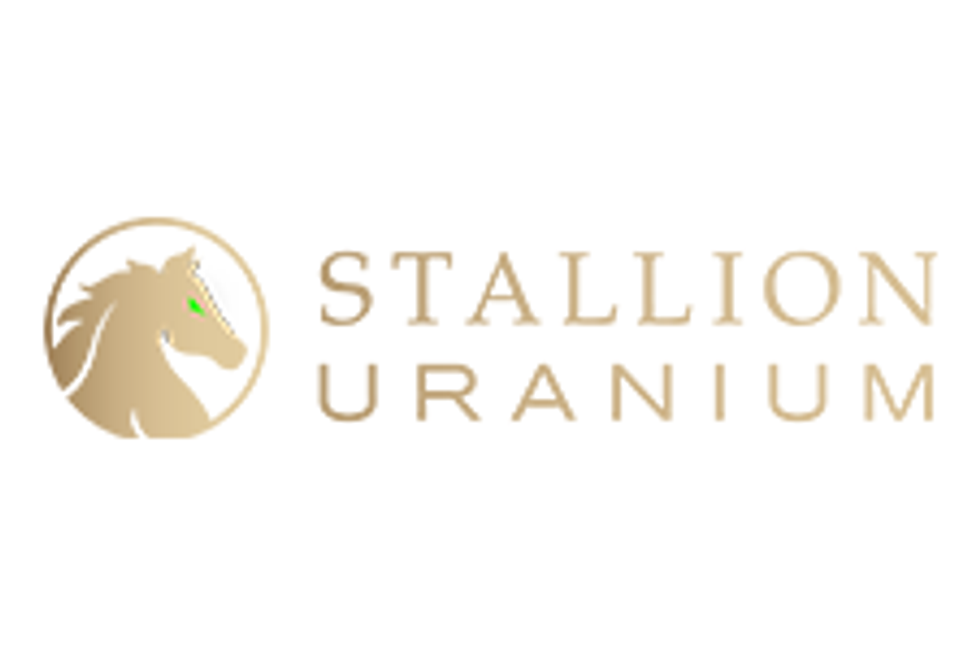
Investor Insight
In the current strong market dynamic for uranium, Skyharbour Resources is a compelling investment opportunity driven by its large portfolio of exploration assets in Canada’s most prolific uranium district in the Athabasca Basin.
Overview
Nuclear energy is a key driver in the transition to net zero, offering clean, reliable, and secure power to meet global electricity demand, which is expected to grow by 50 percent in 2040.
Skyharbour Resources (TSXV:SYH,OTCQX :SYHBF,FWB:SC1P) is strategically positioned to support this growing demand through its high-grade uranium projects. As a leading uranium exploration company, Skyharbour partners with industry stakeholders to advance projects that contribute to the secure and sustainable energy future nuclear power promises.

Skyharbour has launched its winter drill program at the Russell Lake uranium project, initiating its planned 16,000–18,000 metre campaign across 35–45 holes at its co-flagship Russell Lake and Moore projects. This initial phase at Russell will focus on exploring the project’s significant upside potential, leveraging its widespread uranium mineralization and favorable geology for large, high-grade Athabasca Basin uranium deposits.
Company Highlights
- Skyharbour Resources is a junior mining company with an extensive portfolio of uranium exploration projects in Canada’s Athabasca Basin. They comprise 36 uranium projects, totaling over 614,000 hectares.
- The Athabasca Basin is the world’s most prolific uranium jurisdiction, boasting uranium grades averaging over 10-20 times higher than those found elsewhere.
- The company employs a multi-faceted strategy of focused mineral exploration at its core projects (Russell and Moore) while utilizing the prospect generator model to advance its secondary projects with strategic partners.
- The company’s co-flagship Moore project is an advanced-stage uranium exploration asset featuring high-grade uranium mineralization at the Maverick Zone. Previous drilling has returned results of 6 percent U3O8 over 5.9 meters, with a notable intercept of 20.8 percent U3O8 over 1.5 meters, at a vertical depth of 265 meters.
- Adjacent to the Moore project is Skyharbour’s second core project, the Russell Lake uranium project, wherein Skyharbour has completed the acquisition of 57.7 percent interest from Rio Tinto. The Russell Lake uranium project is a large, advanced-stage uranium exploration property totaling 73,314 hectares.
- The 2024 winter drill program at the Russell Lake uranium project led to a new discovery of high-grade, sandstone-hosted mineralization up to 2.99 percent U3O8 intersected over 0.5 meters.
- Skyharbour has commenced its 2025 winter drill program at the Russell Lake uranium project with plans to complete an initial 5,000-metre diamond drilling program in 10 to 12 holes at the project
- Fully-funded for combined drilling of 16-18,000m in 35-45 drill holes across Russell and Moore Lake Projects
- 15-16,000 metres of additional drilling funded by partner companies at other projects in the Skyharbour’s prospect generator business including 6-7,000m of drilling by strategic partner Orano at the Preston project
- Management intends to continue building the prospect generator business by offering projects to partners who will fund the exploration and provide cash/stock to Skyharbour for an ownership interest in the projects; Skyharbour typically retains minority interests in the projects and equity holdings in the partners.
Flagship Projects
The Moore Project

This project covers an area of 35,705 hectares, located in the eastern Athabasca Basin near existing infrastructure with known high-grade uranium mineralization and significant discovery potential. Skyharbour acquired the project from Denison Mines (TSX:DML), a large strategic shareholder of the company. The project can be easily accessed year-round via winter and ice roads, streamlining logistics and reducing expenses. During the summer months, a significant portion of the property remains accessible as well. The property has been the subject of extensive historic exploration with over $50 million in expenditures, and over 140,000 meters of diamond drilling completed historically.
Moore hosts high-grade uranium mineralization at the Maverick zones. Over the past few years, Skyharbour Resources has conducted diamond drilling programs, resulting in the intersection of high-grade uranium mineralization in numerous drill holes along the 4.7-kilometer-long Maverick structural corridor. Some of the high-grade intercepts include:
- Hole ML-199 which intersected 20.8 percent U3O8 over 1.5 meters at 264 meters,
- Hole ML-202 from the Maverick East Zone which intersected 9.12 percent U3O8 over 1.4 meters at 278 meters.
- Hole ML20-09 which intersected 0.72 percent U3O8 over 17.5 meters from 271.5 meters to 289.0 meters, including 1 percent U3O8 over 10.0 meters represents the longest continuous drill intercept of uranium mineralization discovered to date at the project.
- Drill hole ML-61 returned 4.03 percent eU3O8 over 10 meters;
- Drill hole ML -55 encountered high-grade mineralization, returning 5.14 percent U3O8 over 6.2 meters
- Drill hole ML -47 intersected 4.01 percent U3O8 over 4.7 meters
Merely 50 percent of the total 4.7-kilometer promising Maverick corridor has undergone systematic drilling, indicating significant discovery potential both along its length and within the underlying basement rocks at depth. Skyharbour completed a 2024 winter drill program which consisted of 2,800m of drilling at the project which focused on infill/expansion drilling at the Main Maverick Zone. Assay results from the program intersected 5 metres of 4.61 percent U3O8 from a relatively shallow downhole depth of 265.5 metres to 270.5 metres including 10.19 percent U3O8 over 1 metre at the Main Maverick Zone from hole ML24-08. The Company recently received the remaining assay results from its late 2024 diamond drilling program, which totaled 2,759 metres in nine holes. Of the nine holes, four holes (ML24-10 to -12 and ML24-18) focused on the Main Maverick Zone and five holes (ML24-13 to -17) on the Maverick East Zone. The primary objective of the summer program was to extend and expand the boundaries of the Main Maverick and Maverick East Zones with all but one hole successfully intersecting uranium mineralization. Drill hole ML24-15 which intersected 6.4 m of 1.50% U3O8 successfully expands the Maverick East zone over 40 metres along strike to the northeast with more drilling warranted in the area.
Skyharbour is planning for an additional, fully-funded 4,500 – 5,000 metres of drilling at the Main Maverick and Maverick East Zones to further expand, characterize and define the extents of the mineralized zones.
Apart from the Maverick Zone, diamond drilling in various other target areas has encountered multiple conductors linked with notable structural disturbances, robust alteration, and anomalous concentrations of uranium and associated pathfinder elements.
Russell Lake Uranium Project
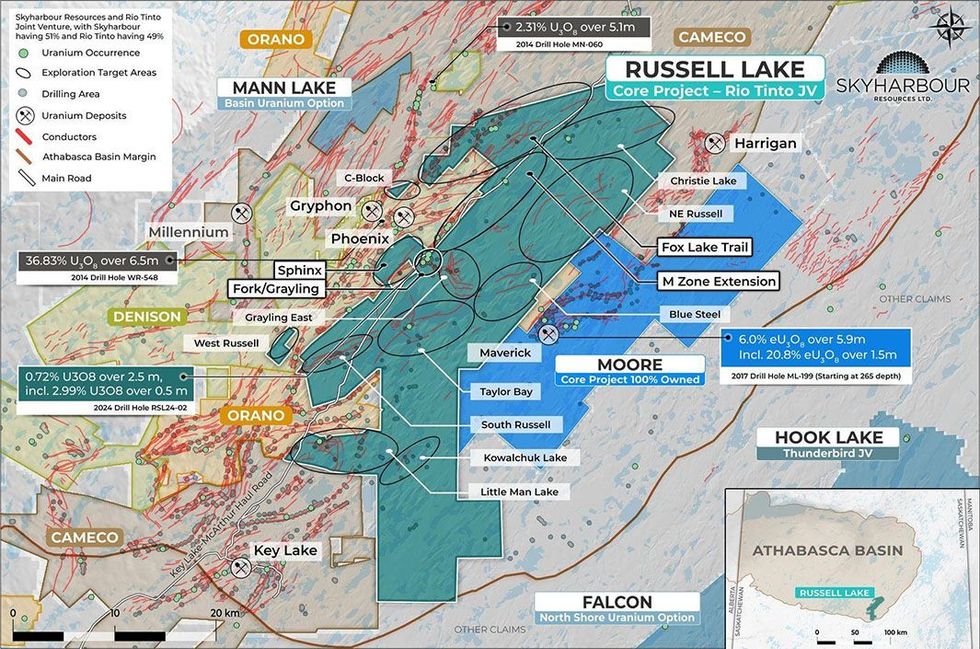
The Russell Lake project is a large, advanced-stage uranium exploration property spanning 73,314 hectares, strategically positioned between Cameco’s Key Lake and McArthur River projects. Skyharbour has completed its earn-in requirements for an option agreement with Rio Tinto and has now acquired 57.7 percent ownership interest in the Russell Lake project.
The project is adjacent to Denison’s Wheeler River project and Skyharbour’s Moore uranium project. It is supported by excellent infrastructure in terms of highway access as well as high-voltage power lines. The project has undergone a significant amount of historical exploration which includes over 95,000 meters of drilling in over 220 drill holes. The exploration identified numerous prospective target areas and several high-grade uranium showings as well as drill hole intercepts.
The property hosts several noteworthy exploration targets, including the Grayling Zone, the M-Zone Extension target, the Little Man Lake target, the Christie Lake target, and the Fox Lake Trail target. Skyharbour completed a 19-hole drilling program totaling 9,595 meters in three phases in 2023. The initial drilling phase encompassed 3,662 meters across eight completed holes at the Grayling Zone, followed by a second phase involving four holes totaling 2,730 meters drilled at the Fox Lake Trail Zone. The third drilling phase involved 3,203 meters across seven holes targeting additional areas within the Grayling Zone.
Drilling at Russell in 2024 was completed in two separate phases with a total of 3,094 metres drilled in six holes. Phase One of drilling resulted in the best intercept of uranium mineralization historically on the property from hole RSL24-02, which returned a 2.5 metre wide intercept of 0.721 percent U3O8 at a relatively shallow depth of 338.1 metres, including 2.99 percent U3O8 over 0.5 metres at 339.6 metres just above the unconformity in the sandstone. The second phase of drilling was recently completed which totalled approximately 4,500 metres, with assays pending.
Skyharbour has recently commenced its 2025 drilling program at the Russell Lake project with a first phase consisting of approximately 5,000 metres to follow up on notable recent exploration success and to test new targets developed by the geological team. The focus for this phase of drilling will be on the Fork and Sphinx targets within the broader Grayling target area, as well as the M-Zone Extension target and the Fox Lake Trail target. This initial winter program will consist of 10 to 12 drill holes, with most of the targets being road accessible and near the exploration camp, bringing the drill costs down.
Prospect Generator Strategy
In addition to being a high-grade uranium exploration and early stage development company, Skyharbour utilizes a prospect generator strategy by bringing in partner companies to acquire interests in some of our secondary projects by funding exploration at these projects and making cash and share payments to Skyharbour over a period of time. This model allows the Company to focus efforts and capital at our core projects which include the Moore Lake and Russell Lake Projects, while having our JV and option partner companies fund and advance our secondary projects.
Skyharbour partner companies include Orano Canada, Azincourt Energy, Thunderbird Resources, Basin Uranium Corp., North Shore Uranium and Terra Clean Energy, advancing the Preston, East Preston, Hook Lake, Mann Lake, Falcon and South Falcon East Projects, respectively. More recently, three new earn-in option agreements have been signed with UraEx Resources at the South Dufferin and Bolt Projects, Hatchet Uranium at the Highway Project, and Mustang Energy at the 914W Project, bringing the total partner companies to nine. Skyharbour now has option agreements that total over CAD $36 million in exploration expenditures, over $20 million in stock being issued and $14 million in cash payments coming into Skyharbour, assuming that these partner companies complete their full earn-ins at their respective projects.
Furthermore, Skyharbour's project portfolio is bolstered by several other 100% owned projects scattered throughout the Athabasca Basin that they can look to option/JV or sell to grow their robust model.
Management Team
Jordan Trimble - President and CEO
With a background in entrepreneurship, Jordan Trimble has held various positions in the resource industry, focusing on management, corporate finance, strategy, shareholder communications, business development, and capital raising with multiple companies. Prior to his role at Skyharbour, he was the corporate development manager at Bayfield Ventures, a gold company with projects in Ontario. Bayfield Ventures was subsequently acquired by New Gold (TSX:NGD) in 2014. Throughout his career, Trimble has established and assisted in the management of numerous public and private enterprises. He has played a pivotal role in securing significant capital for mining companies, leveraging his extensive network of institutional and retail investors.
Jim Pettit – Chairman of the Board
Jim Pettit currently serves as a director on the boards of various public resource companies, drawing from over 30 years of experience in the industry. His expertise lies in finance, corporate governance, management and compliance, particularly in the early-stage development of both private and public enterprises. Over the past three decades, he has primarily focused on the resource sector. Previously, he served as chairman and CEO of Bayfield Ventures, which was acquired by New Gold in 2014.
David Cates - Director
David Cates currently serves as the president and CEO of Denison Mines (TSX:DML). Before assuming the role of president and CEO, Cates was the vice-president of finance, tax, and chief financial officer at Denison. In his capacity as CFO, he played a pivotal role in the company's mergers and acquisitions activities, including spearheading the acquisition of Rockgate Capital and International Enexco. Cates joined Denison in 2008, initially serving as director of taxation before he was appointed CFO. Prior to joining Denison, he held positions at Kinross Gold and PwC with a focus on the resource industry.
Joseph Gallucci - Director
Joseph Gallucci was previously a senior manager at a leading Canadian accounting firm. He possesses more than two decades of expertise in investment banking and equity research, specializing in mining, base metals, precious metals, and bulk commodities worldwide. He serves as a senior capital markets executive and corporate director. Presently, Gallucci is the managing director and head of investment banking at Laurentian Bank Securities, where he assumes responsibility for overseeing the entire investment banking practice.
Brady Rak - VP of Business Development
Brady Rak is a seasoned investment professional who has focussed on the Canadian capital markets over his 13-year career at several independent broker dealers including Ventum Financial, Salman Partners and Union Securities. As a registered investment advisor in the private client division of Ventum Financial, Brady has been involved in advising high-net-worth and corporate clients, structuring transactions, raising capital and navigating global market sentiment. Brady graduated from Northwood University with a BBA in Management and holds his Options license.
Serdar Donmez - Vice-president of Exploration
A recognized geoscientist with decades of experience in uranium exploration and development, Serdar Donmez has played an active role in numerous grassroots and advanced uranium exploration projects in northern Saskatchewan and Zambia. Donmez has an engineering degree in geology and is a registered professional geoscientist with the Association of Professional Engineers and Geoscientists of Saskatchewan. During his 17-year tenure at Denison Mines, Donmez was pivotal in advancing numerous uranium exploration and development projects. He was involved in various capacities with the Phoenix and Gryphon uranium deposits on Denison's Wheeler River project, from initial discovery to the completion of the feasibility study in 2023. As resource geology manager, he was integral to the development of mineral resource estimates and NI 43-101 technical reports for several advanced exploration projects in the Athabasca Basin. Additionally, he was part of a team exploring the application of in-situ recovery mining techniques for high-grade uranium deposits in the Athabasca Basin.
Dave Billard - Head Consulting Geologist
Dave Billard is a geologist with over 35 years of experience in exploration and development, focusing on uranium, gold and base metals in western Canada and the western US. He served as chief operating officer, vice-president of exploration, and director for JNR Resources before its acquisition by Denison Mines. He played a crucial role in the discovery of JNR’s Maverick and Fraser Lakes B zones. Earlier in his career, he contributed to the discovery and development of several significant gold deposits in northern Saskatchewan. Prior to joining JNR, Billard worked as a geological consultant specializing in uranium exploration in the Athabasca Basin. He also spent over 12 years with Cameco Corporation.
Christine McKechnie - Senior Project Geologist
Christine McKechnie is a geologist with a specialization in uranium deposits, particularly those hosted in the basement and associated with unconformities in the Athabasca Basin and its vicinity. Throughout her career, she has worked with various companies such as Claude Resources, JNR Resources, CanAlaska Uranium and Cameco, engaging in gold and uranium exploration activities. She completed her B.Sc. (High Honors) in 2008 from the University of Saskatchewan and completed a M.Sc. thesis on the Fraser Lakes Zone B deposit at the Falcon Point project. She also received the 2015 CIM Barlow Medal for Best Geological Paper.
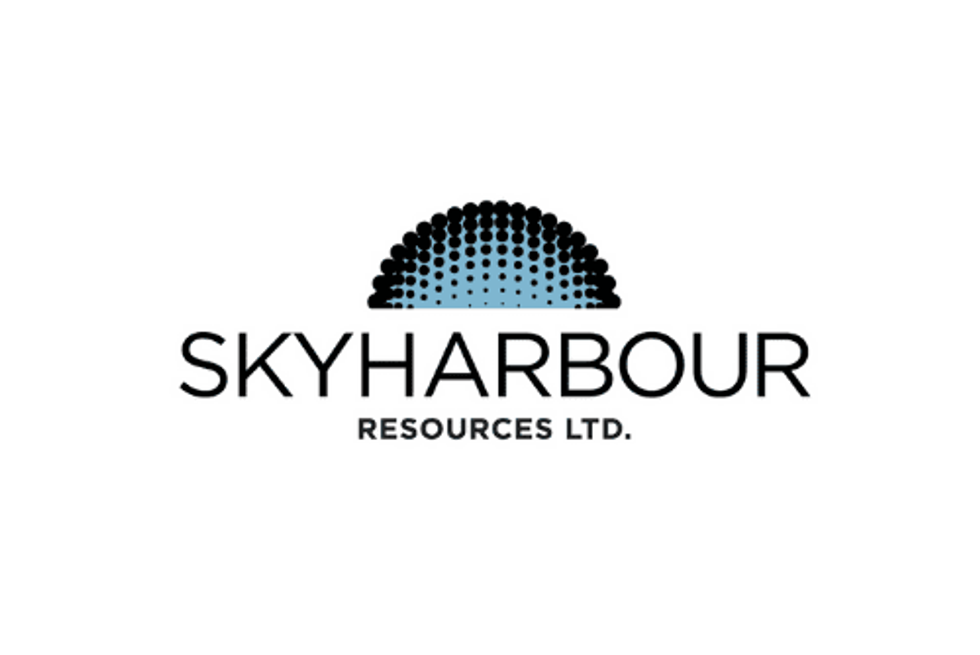
Investor Insight
Greenvale Energy offers investors exposure to the high-growth nuclear energy sector through its highly prospective uranium projects, complemented by strategic assets with high-value bitumen and renewable geothermal energy potential, all managed by an experienced team with a proven track record of shareholder value creation.
Company Highlights
- Uranium exploration portfolio across the Northern Territory and Queensland
- Advanced-exploration, high-grade Oasis project with intercepts up to 0.72 percent U3O8 (15.8 lbs/ton)
- Strategic coverage of the Northern Territory, with four uranium projects targeting sandstone hosted and unconformity style deposits
- Alpha Torbanite project with 28 Mt inferred resource, positioned to be the only local producer that can supply Australia’s bitumen market (consuming ~1 Mt annually through 100 percent imported material)
- Millungera Basin geothermal project with potential for 3.4 GW continuous power generation
- Experienced board and management team, Chaired by Neil Biddle, founding director of Pilbara Minerals
- Substantial R&D grant support for the Alpha Torbanite project, having successfully secured over $3 million in non-dilutive grant funding
- Projects aligned to the long-term zero-carbon energy transition
Overview
Greenvale Energy (ASX:GRV) is an ASX-listed exploration company with a portfolio of projects that will support a sustainable, low-carbon future. The Company has early-stage uranium exploration projects in the Northern Territory, the Oasis advanced-exploration project in Queensland and the Alpha Torbanite and Millungera Basin geothermal projects in Queensland. The Company believes the best way to create long-term shareholder value is by investing in exploration, to make discoveries and grow its resource-base.

The company's uranium projects in Queensland and the Northern Territory are particularly significant as global nuclear energy demand accelerates. With nuclear power projected to grow 300 percent by 2050, with nuclear power forecast to supply 30 percent of global power demand, Greenvale is positioned perfectly to leverage the expanding and globally-significant market opportunity. Major technology companies including Amazon, Google and Meta have committed to supporting the goal of tripling global nuclear capacity by 2050, further validating the sector's growth trajectory.Greenvale's portfolio includes the promising Oasis uranium project with high-grade intercepts up to 0.72 percent U3O8, four uranium projects across the Northern Territory, the Alpha Torbanite project, and the Millungera geothermal project in Queensland.
Key Projects
Uranium Projects
Oasis Project (Queensland)
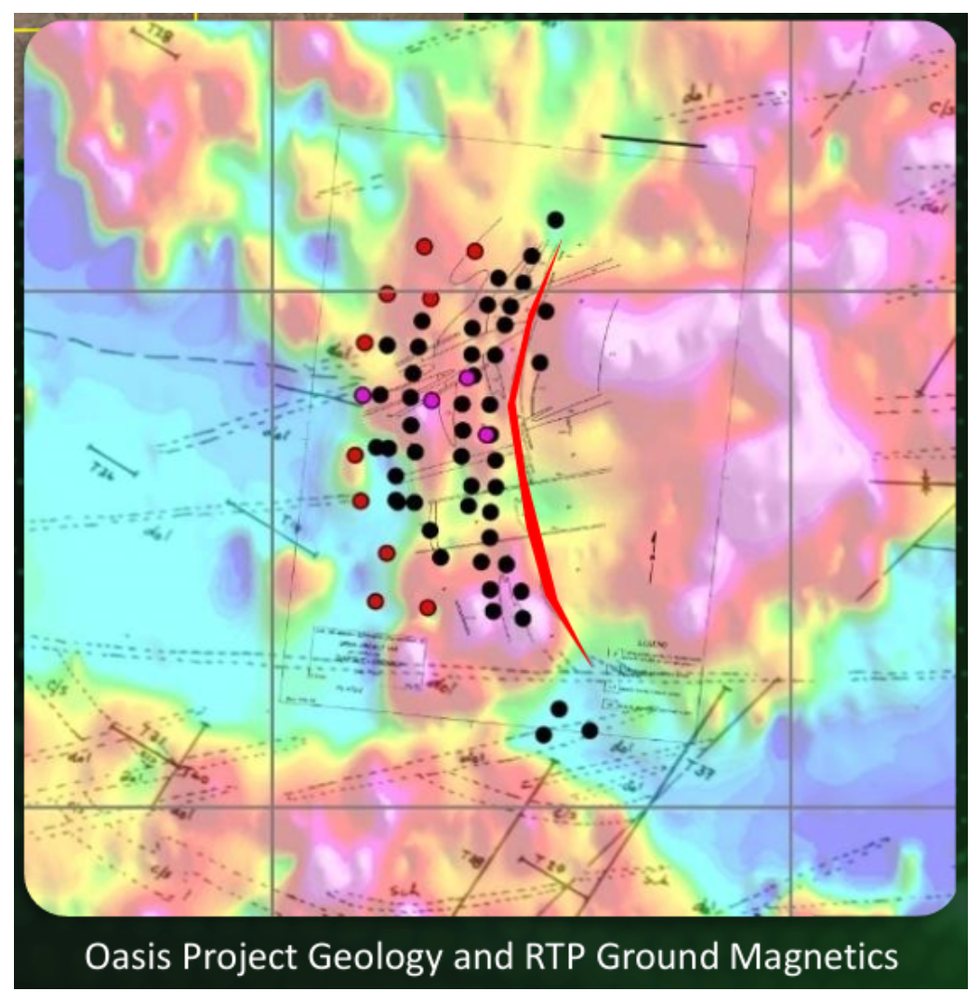
The Oasis project is an advanced-exploration Project, featuring exceptional high-grade intercepts up to 0.72 percent U3O8 (15.8 lbs/ton). Originally discovered in 1973, the deposit has seen sporadic exploration including significant work by Esso in 1978/79. The project area contains extensive radiometric anomalies with multiple faults and fractures controlling the distribution of uranium mineralization.
Greenvale has developed a comprehensive work program for Oasis, beginning with regional geological field prospecting and reconnaissance, followed geophysical and geochemical surveys across the Oasis prospect and regional areas. These preliminary works are key to develop and refine targets for Greenvale’s planned maiden drill program at Oasis.
Northern Territory Uranium Projects
Greenvale has four strategic uranium projects in the Northern Territory: Jindare project in Douglas River, Henbury, Elkedra and Tobermorey. These projects target sandstone hosted and unconformity style uranium mineralization, with particular focus on areas where uranium-bearing waters may interact with hydrocarbons, creating optimal conditions for uranium deposition. The geology of these assets is similar to uranium deposits in Kazakhstan, the world’s leading producer of uranium.
The Henbury project is particularly noteworthy, located on the edge of the Amadeus Basin, a major hydrocarbon basin in the Northern Territory. Following research from Geoscience Australia, Greenvale is targeting areas at the margins of hydrocarbon cap-rocks near active structures, which represent prime locations for uranium mineralization.
Alpha Torbanite Project
The Alpha Torbanite Project represents a unique opportunity to supply Australia's infrastructure sector with domestically-produced bitumen. The project features a substantial 28 Mt inferred resource of torbanite and cannel coal, positioning Greenvale to potentially capture a significant share of Australia's annual bitumen consumption (currently assessed as approximately 1 Mt all serviced through material imported from overseas).

Torbanite is a rare type of oil shale containing exceptionally high concentrations of algal-derived hydrocarbons that can be processed to produce high-quality bitumen products. This natural conversion capability makes torbanite deposits like Alpha particularly valuable for infrastructure applications as they can yield bitumen substitutes with properties comparable to petroleum-derived products.
To date, the company has been able to secure over $3 million in non-dilutive R&D grant funding to support project development.. The Company's test program continues to show improved results, with test program 7 planned to produce a bulk sample for certification. Certification will underpin the progression of feasibility studies that will define the full economic potential of the project.
Queensland Geothermal Project
Greenvale's Millungera Basin geothermal project targets one of Australia's most prospective areas for geothermal energy. The basin contains the hottest rock formations in Queensland, with a total identified stored thermal energy potential exceeding 611,000 PJ (at 90 percent probability). Technical reports indicate the potential for an estimated annual electricity generation of 29,621 GWh from inferred resource areas, with capacity to produce 3.4 GW continuously.
Management Team
Neil Biddle - Executive Chairman
A geologist with over 40 years' experience in exploration and mining, Neil Biddle was a founding director of Pilbara Minerals, where he oversaw the acquisition, exploration and development of the world-class Pilgangoora lithium project. His extensive industry experience provides Greenvale with strong leadership and strategic direction.
Alex Cheeseman - Chief Executive Officer
A highly experienced Australian resources executive, Alex Cheeseman has over 20 years’ experience in operational leadership and project development across a range of industries. He has held general manager and CEO-level roles in a number of ASX-listed exploration and mining companies with experience in a range of commodities including iron ore, lithium and base metals. He has a demonstrated track record of success in resource project development, capital markets, corporate development and commodity marketing.
Elias Khouri - Non-executive Director
Bringing extensive experience in equity capital markets, Elias Khouri offers expertise in corporate finance, advisory, capital raisings and joint venture negotiations, enhancing the company's financial and strategic capabilities.
John Barr - Non-executive Director
John Barr is a chartered accountant with more than 25 years of experience as a company director. He was a founding director of Mosman Oil and Gas. His extensive Australian and international experience spans manufacturing, mining and oil and gas industries.
Peter Harding-Smith - Chief Financial Officer & Company Secretary
Peter Harding-Smith brings extensive experience in company financial reporting, corporate regulatory and governance areas, business acquisition and disposal due diligence, capital raising, and company secretarial responsibilities.
Zoe Stackhouse - Exploration Manager
Zoe Stackhouse is a geologist with 20 years' experience in unconventional gas exploration and production. Stackhouse also serves as secretary of the Australian Geothermal Association, bringing specialized expertise to Greenvale's geothermal initiatives.
Mark Turner - Technical Consultant (Alpha Project)
An engineer with over 25 years' experience in the energy sector, Mark Turner has a proven track record of major project delivery across oil & gas, water, power, renewables and nuclear projects.
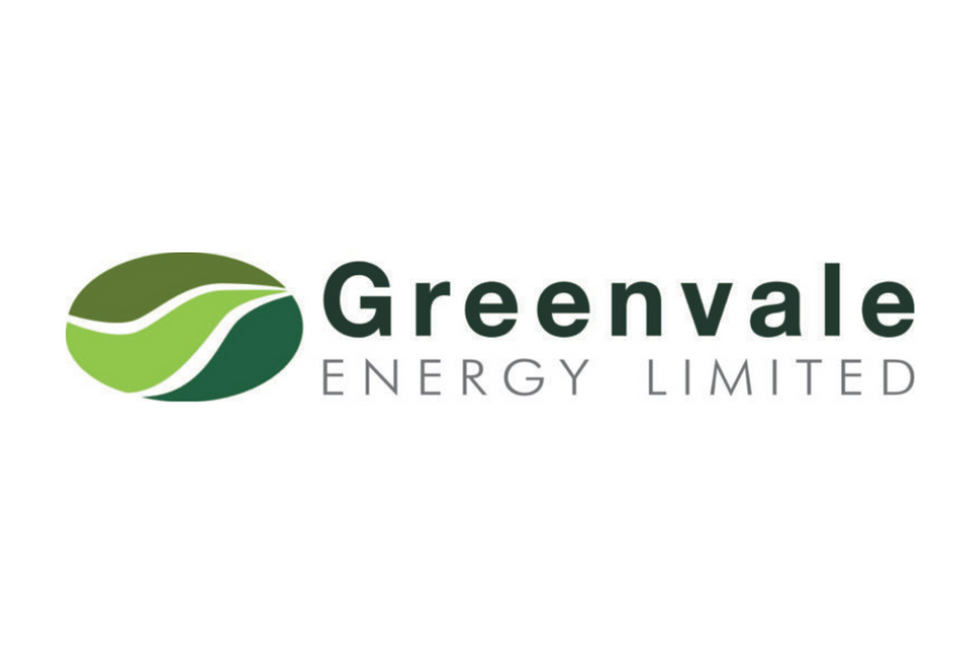
Browse Companies
MARKETS
COMMODITIES
CURRENCIES